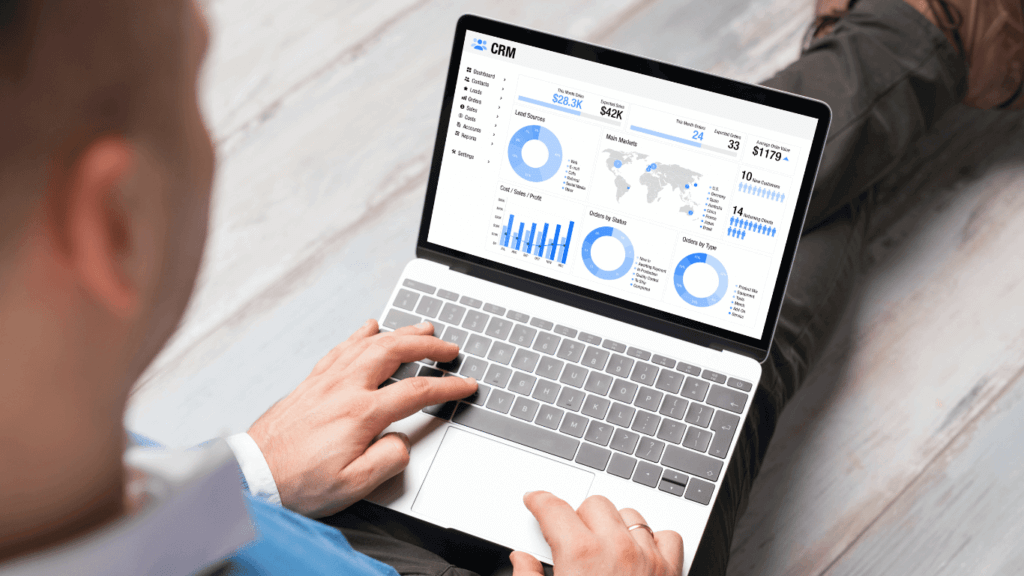The ability to navigate the fast-paced world of sales is invaluable and this is where sales analytics comes into play. With data-driven decisions now paramount, sales teams can take advantage of data and analytics to boost their strategies and see increased revenue growth.
The truth is, that data-driven decisions are the secret sauce behind every successful sales strategy. It’s not just for the big players either—it’s a tool that can empower businesses of all sizes to thrive.
That being said, it’s time to demystify sales analytics and show you how it can become your trusted ally in making sales a breeze. Whether you’re a seasoned sales pro or just dipping your toes into the sales waters, this guide is designed to help you navigate the terrain effortlessly.
The basics of sales analytics

At its core, sales analytics is like having a crystal ball for your business. It’s the art and science of gathering, processing, and interpreting data related to your sales and marketing efforts together.
So what makes sales analytics such a big deal? Well, imagine that you’re driving blindfolded. You might get somewhere, but the chances of crashing along the way and getting injured are pretty high. Sales analytics basically removes that blindfold. It gives you clear, actionable insights into your sales performance, customer behavior, and market trends.
So, in plain English, sales analytics helps you answer questions like:
- How are our sales performing?
- Who are our most valuable customers?
- What products or services are our top sellers?
- Are our lead generation efforts paying off?
- Where should we focus our sales efforts to maximize profits?
The benefits of sales analytics
Sales analytics can provide numerous benefits. Imagine having a personal assistant who can predict the future sales of your business. That’s what sales analytics does for you. Here’s why it’s your new best friend in the business world:
Improved decision-making
Say goodbye to gut feelings and hello to data-backed decisions. Sales analytics equips you with the information you need to make choices that drive sales growth, and profitability.
Enhanced sales performance
By understanding what’s working and what isn’t, you can fine-tune your sales planning to come up with strategies for maximum effectiveness. It’s like having a coach who helps you score more goals.
Better customer insights
You’ll get to know your customers on a deeper level. What do they want? When do they want it? How do they want it delivered? With these insights, you can tailor your offerings to meet their needs precisely.
Stay ahead of the curve
In the fast-paced world of business, staying ahead of the competition is crucial. Sales analytics helps you identify market trends and emerging opportunities before your rivals do.
Boosted efficiency
No more wasting time and resources on strategies that don’t work. Sales analytics helps you allocate your resources where they matter most, maximizing efficiency and ROI.
Essential components of sales analytics

So what makes up the engine of the sales analytics process? These components are the gears and gadgets that power the whole machine. We’re breaking them down into three key parts:
Data collection and quality
Accurate and reliable data is of utmost importance for successful sales analytics. After all, the quality of the information collected serves as an important foundation to allow businesses to analyze results with assurance.
Imagine data as the bricks of your business foundation. Without solid bricks, your business could crumble. Data collection is all about gathering these bricks. But it’s not about hoarding all the bricks you can find—it’s about choosing the right ones and ensuring they’re in tip-top shape.
There are two things to remember when it comes to data collection:
- Choosing the right data: Start by collecting data that directly relates to your sales goals. It’s like collecting puzzle pieces that fit together to form the big picture. These pieces can include customer information, sales figures, website traffic, and more.
- Quality over quantity: Remember, it’s not about the sheer volume of data—it’s about its quality. Ensure your data is accurate, up-to-date, and relevant. After all, you wouldn’t build a house with cracked or mismatched bricks, right? You don’t want to base your decisions on faulty data.
Analytical techniques and approaches
Once you have your data bricks, it’s time to turn them into a sturdy structure. This is where analytical techniques and approaches come into play—also known as the architects and engineers of your data-driven world. This involves:
- Data crunching: Analytics isn’t just about looking at numbers. It’s about making those numbers talk. This involves using techniques like regression analysis, data modeling, and forecasting methods to extract meaningful insights from your data.
- Patterns and trends: Your data isn’t just a bunch of numbers; it’s a treasure trove of patterns and trends waiting to be discovered. Analytical approaches help you uncover these hidden gems, giving you a competitive edge.
Essential tools for sales analytics
To make the most of sales analytics, businesses must have access to powerful tools such as CRM systems and data visualization platforms. This provides a secure platform for collecting and managing customer information while allowing analysis and interpretation of their various sales reports and numbers with ease.
When searching for an ideal tool, it’s important to look out for these two things:
- User-friendly platforms: Thankfully, you don’t need to be a data scientist to make sense of your data. There are many user-friendly analytics platforms available that let you explore and visualize your data effortlessly.
- Integration capabilities: These tools should seamlessly integrate with your existing systems, whether it’s your CRM, email marketing software, or eCommerce platform. Integration means your data flows smoothly, reducing headaches and hassles.
Essentially, data collection ensures you’re building on a sturdy foundation, analytical techniques help you design the blueprint, and essential tools are your trusty toolbox. In the next section, we’ll unveil the key metrics you need to monitor and optimize for sales success.
Key sales metrics to monitor and optimize

Sales conversion rate
The sales conversion rate is the percentage of leads or prospects that turn into actual customers. For example, if you have 100 leads and 20 of them become customers, your conversion rate is 20%.
A high conversion rate means that your sales process is efficient and persuasive. A low rate suggests room for improvement. Monitoring sales team’s performance against this metric helps you pinpoint where potential customers might be falling through the cracks.
How to optimize it: To boost your conversion rate, analyze your sales process step by step. Identify bottlenecks, objections, or areas where prospects seem to drop off. Tailor your sales strategies and communication to address these issues and provide more value to your leads.
Customer acquisition cost (CAC)
Customer Acquisition Cost (CAC) represents the total expenses associated with acquiring new customers. This includes marketing costs, sales team salaries, advertising expenses, and any other costs associated with acquiring customers.
Understanding the cost of acquiring a customer is crucial for maintaining a healthy profit margin. A high CAC relative to your customer lifetime value (CLV) can indicate that you’re spending too much to acquire customers, potentially eating into your profits.
How to optimize it: To lower CAC, consider refining your sales and marketing efforts and strategies to target more qualified leads. Optimize your advertising campaigns, focus on high-converting channels, and ensure your sales team is efficiently closing deals.
Average deal size
This refers to the mean amount of revenue generated from individual sales transactions. It provides insights into the size of your typical sale.
Monitoring your average deal size helps you gauge the overall health of your sales pipeline. It can also indicate opportunities for upselling or cross-selling to increase revenue per customer.
How to optimize it: To increase your average deal size, explore strategies such as bundling related products or services, offering premium options, and implementing effective pricing strategies.
Sales velocity
Sales velocity helps you understand how quickly deals are moving through your sales pipeline.—how fast your sales team progresses from the initial contact with a lead to closing the sale. It’s typically calculated as: (Number of Deals) x (Average Deal Value) x (Win Rate) / (Sales Cycle Length).
A higher sales velocity indicates that your sales process is efficient and that you can generate revenue more quickly. Meanwhile, slower velocity might suggest bottlenecks or a need to streamline your sales process.
How to optimize it: Focus on shortening your sales cycle by identifying and addressing any delays or obstacles. Then formulate the solutions for these issues, such as better lead qualification, more effective nurturing, or quicker responses to inquiries.
Customer retention rate
While acquiring new customers is vital, keeping existing ones is equally important. Customer retention rate measures your ability to keep customers coming back. It is the percentage of customers who continue to do business with you over a specific period.
It’s calculated as: (Number of Customers at the End of the Period – Number of New Customers Acquired During the Period) / Number of Customers at the Start of the Period.
A high retention rate indicates that you’re providing value and maintaining strong relationships with your customers. Retaining customers is often more cost-effective than acquiring new ones.How to optimize: Focus on delivering exceptional customer service, personalized experiences, and loyalty programs. Actively engage with your existing customers to address their needs and concerns.
Implementing sales analytics: best practices

Implementing sales analytics is not just about collecting data; it’s about making it work for your business. Here are some best practices to ensure a smooth and effective implementation:
- Set clear goals and objectives: Define what you want to achieve. Are you looking to increase revenue, improve customer retention, or streamline your sales process? Having clear objectives will guide your analytics efforts.
- Choose the right analytics tools: Select analytics tools that align with your business needs and goals. Ensure they can integrate with your existing systems to make data collection and analysis seamless.
- Invest in data quality: Garbage in, garbage out. Ensure your data is accurate, consistent, and up-to-date. Regularly clean and validate your data to avoid making decisions based on faulty information. Check out this guide on data hygiene.
- Train your team: Equip your sales and marketing teams with the necessary skills to use analytics tools effectively. Training ensures that your staff can interpret data and apply insights to their daily activities.
- Data visualization: Utilize data visualization techniques to present complex information in an easily digestible format. Visual dashboards and reports help team members quickly grasp insights.
- Regularly Review and Analyze Data: Make data analysis a routine part of your sales process. Regularly review performance metrics, identify trends, and adjust strategies accordingly.
- Iterate and improve: Sales analytics is an ongoing process. Don’t be afraid to iterate and refine your approach based on new insights and changing market conditions.
- Data security: Ensure the security of your data. Implement encryption, access controls, and backup procedures to protect sensitive customer information.
- Stay informed about industry trends: The world of analytics is constantly evolving. There’s always something new. Stay up-to-date with industry trends and emerging technologies to remain competitive.
- Document your processes: Create documentation outlining your analytics processes and best practices. This helps maintain consistency and provides a reference for new team members.
- Celebrate wins and learn from losses: Acknowledge and celebrate successes that result from data-driven decisions. Equally important, use failures as learning opportunities to refine your strategies.
Common challenges in sales analytics (and how to overcome them)

Implementing sales analytics can be incredibly beneficial, but it’s not without its challenges. Fortunately, understanding and addressing these challenges can pave the way for success.
Here are some common hurdles in sales analytics and how to overcome them:
- Data quality issues
- Challenge: Inaccurate or incomplete data can lead to flawed insights and poor decision-making.
- Solution: Invest in data quality processes, data cleansing tools, and regular data audits to ensure the accuracy and reliability of your data.
- Resistance to change
- Challenge: Team members may resist adopting new analytics tools or processes, fearing disruptions or added complexity.
- Solution: Provide comprehensive training and clear explanations of the benefits of analytics. Show how it can help and make their jobs easier and more productive.
- Resource constraints
- Challenge: Limited budget and staffing can hinder the adoption of advanced analytics solutions.
- Solution: Start with affordable, user-friendly analytics tools that align with your budget. As you see ROI, consider expanding your analytics capabilities.
- Data security and privacy concerns
- Challenge: Protecting customer data and complying with data privacy regulations can be complex.
- Solution: Implement robust data security measures, encryption, and access controls. Stay informed about data privacy regulations like GDPR or CCPA and ensure compliance.
- Overwhelming data volume
- Challenge: The sheer volume of data can be overwhelming, making it challenging to extract meaningful insights.
- Solution: Focus on relevant data and key performance indicators (KPIs). Use analytics tools to filter and visualize the most critical information.
- Difficulty in measuring ROI
- Challenge: Some businesses struggle to quantify the return on investment from their sales analytics efforts.
- Solution: Set clear objectives and key performance indicators (KPIs) before implementing analytics. Regularly evaluate the impact of analytics on these metrics.
The future of sales analytics: trends and innovations

The world of sales analytics is always evolving. To stay ahead of the curve and make the most out of your data, it’s crucial to keep an eye on emerging trends and innovations.
Here’s a glimpse into what the future of sales analytics holds:
- Predictive analytics will become even more advanced, leveraging machine learning and AI to forecast sales trends with greater accuracy. This will help businesses proactively address opportunities and challenges.
- AI-driven virtual sales assistants will become commonplace. These digital helpers can provide real-time insights, recommend sales strategies, and even automate routine tasks, freeing up sales teams to focus on high-value activities.
- Personalization at scale. Sales analytics will enable hyper-personalization at scale. With AI-driven insights, businesses can tailor their offerings and communications to individual customers, increasing engagement and conversions.
- Augmented reality (AR) will find its way into sales and marketing. Virtual product demonstrations and interactive experiences will help customers make informed decisions and improve the buying process.
- Sales process automation will continue to grow. From lead scoring to follow-up emails, automation will help streamline sales tasks, allowing teams to focus on relationship-building.
- Blockchain technology will play a role in ensuring transparency and trust in sales transactions. It can be used for secure and immutable record-keeping, reducing disputes and fraud.
- Sales analytics will seamlessly integrate across various channels—from social media to in-store interactions—to create a unified customer view, helping businesses understand the customer journey comprehensively.
Let’s embark on your analytics journey together
With the power of data in your hands, you can make informed choices that drive your business forward. Sales analytics isn’t just about numbers; it’s about understanding your customers, optimizing your sales processes further, and staying agile in a dynamic marketplace. So, where do you go from here? It’s time to put these insights into action. Implementing sales analytics may seem like a mountain to climb, but with the right tools, strategies, and mindset, you’ll find it’s a journey well worth taking.
At TaskDrive, we understand the power of data and the potential it holds for your sales success. Our team of experts is ready to assist you in harnessing the full potential of sales analytics, from data collection to actionable insights.
Contact TaskDrive today, and let’s take your business to new heights through the transformative power of data.



